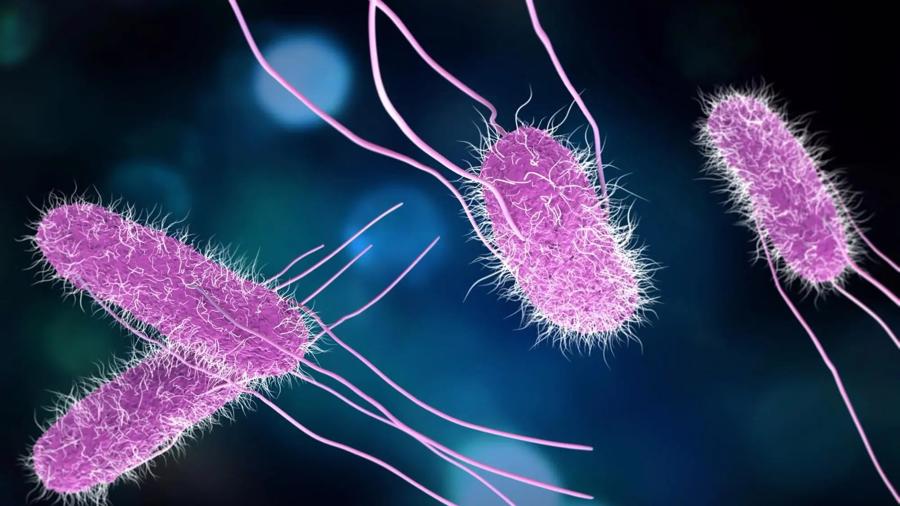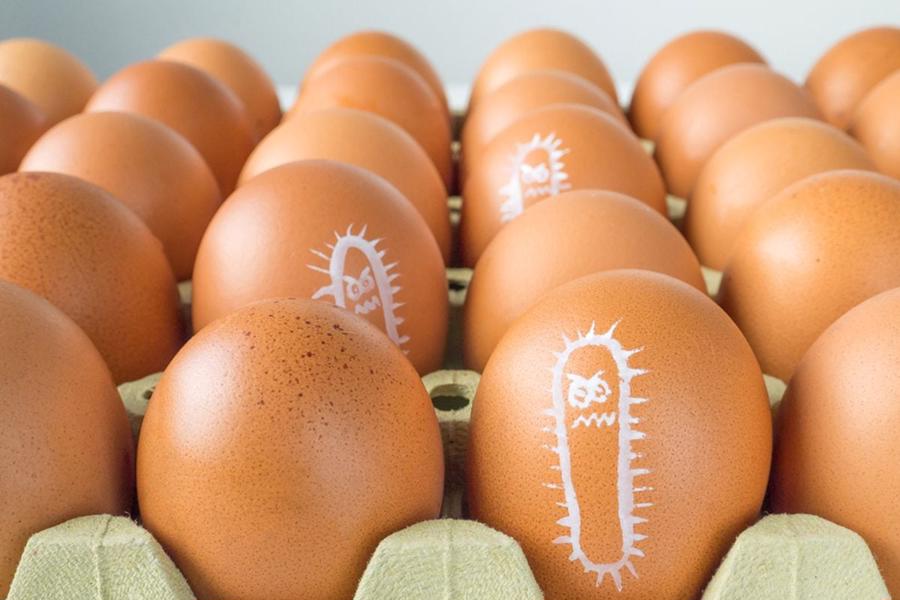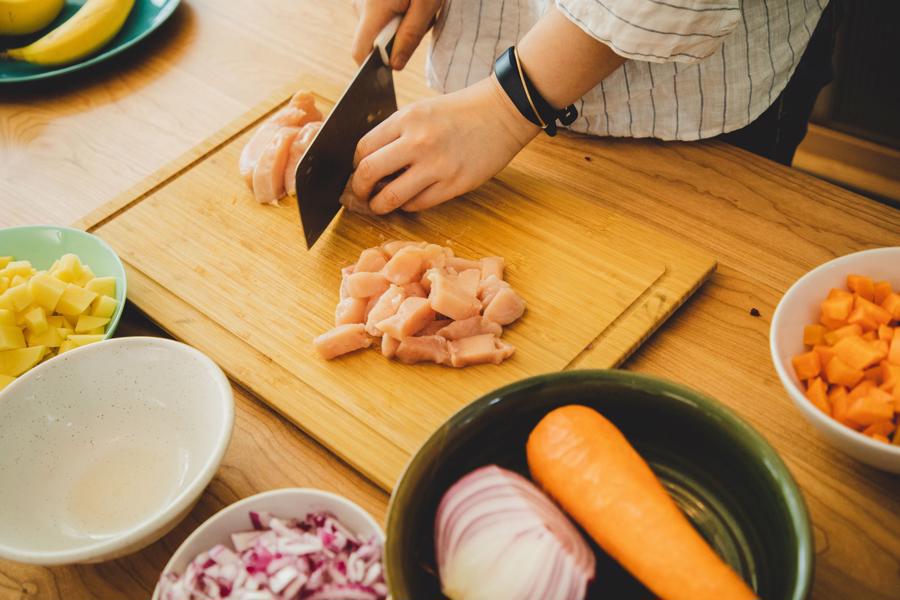Previously, Salmonella bacteria also caused food poisoning in hundreds of students in Nha Trang, one of whom died, in 2022. In September 2023, Salmonella bacteria were also detected in barbecued pork; lettuce, laksa leaves, onions, cucumbers, and dumplings after testing 12 samples of Phuong bread in Hoi An.
Salmonella is one of the leading causes of diarrhea worldwide, including many large-scale poisoning cases, according to the World Health Organization. In April 2022, some European countries warned and recalled Kinder chocolate eggs suspected of being contaminated with Salmonella bacteria.
Associate Professor, Dr. Nguyen Duy Thinh, former staff member of the Institute of Biotechnology and Food Technology, Ho Chi Minh City University of Technology, said that Salmonella bacteria can appear in any type of raw meat, the most common being poultry such as chicken, ducks, geese. During the processing, if the cook does not follow the principles of processing raw food – cooked, does not wash their hands properly, the bacteria from raw food will contaminate the cooked food and quickly multiply. The more bacteria there are, the greater the amount of toxins it produces.

According to Associate Professor Nguyen Anh Tuan, Head of the Department of Endoscopic Surgery, Digestive System Hospital of 108 Military Central Hospital, Salmonella bacteria develop rapidly in a hot and humid environment (35 – 37 degrees Celsius). When butchering livestock, poultry, if not properly cleaned, Salmonella bacteria will spread to the environment and cling to foods such as meat, poultry eggs. Eating raw eggs, improperly boiled eggs, people can also be infected with Salmonella bacteria. Vegetables and milk are also susceptible to Salmonella contamination from animal feces.
When this bacterium enters the human body, it will grow and release toxins that irritate the intestines, causing abdominal pain, nausea, and diarrhea. A large amount of bacteria can invade the blood and cause blood infection. Salmonella food poisoning can appear one day after eating, but there are also cases after 4 – 5 days. Compared to E. coli, Salmonella poisoning symptoms are more severe and dangerous. Patients experience abdominal cramps, chills, diarrhea, fever, muscle aches, nausea, vomiting, signs of dehydration such as dark urine, dry mouth, low energy, and bloody stool. Some cases have headaches, insomnia, rashes…
Dr. Nguyen Trung Nguyen, Director of the Toxic Control Center, Bach Mai Hospital, said that normally, doctors will treat with antibiotics, usually antibiotics that kill Salmonella bacteria can take 5-7 days, continue to balance intestinal bacteria and treat symptoms. The aforementioned symptoms often last from a few days to a week. Among them, diarrhea usually lasts about 10 days but can last for several months before the intestines return to stable bowel habits.

According to the US Centers for Disease Control and Prevention (CDC), Salmonella bacteria are found in some types of foods such as:
– Meat: chicken, turkey, beef, pork: The CDC says some recent Salmonella outbreaks are mostly related to chicken. You can get infected if the chicken is contaminated and not properly cooked. You can also get infected if raw chicken drips in the refrigerator or sticks to the kitchen counter and then sticks to raw food like raw vegetables, cold cuts.
– Unpasteurized milk and dairy products: Unpasteurized milk and dairy products can be contaminated with Salmonella bacteria. While the pasteurization process can eliminate harmful bacteria, including Salmonella.
– Raw or undercooked eggs: Although the eggshell can protect the inside from contamination, poultry can lay eggs containing Salmonella bacteria (exist while the shell is being formed). This is the source of infection for humans.
– Fruits and vegetables: Fresh fruits and vegetables, especially imported varieties, can be contaminated with Salmonella bacteria during cultivation or washing with water. Improperly processed food: Many types of food are contaminated with Salmonella bacteria due to improper processing, mainly due to not washing hands thoroughly before handling.
– Source from livestock and various reptiles: Animals in general, including pets, especially birds and reptiles, can carry Salmonella bacteria on their feathers, skin, and feces. Therefore, this is also a source of infection to be noted.
The spread of Salmonella bacteria can be effectively prevented by stopping the source of infection from the beginning. Specifically, always wash hands with soap and clean water after going to the toilet. Wash your hands thoroughly before and after cooking or eating. Clean surfaces and utensils before and after using them to prepare food. Make sure that food is cooked to a safe temperature before eating. Do not handle any other type of food while processing, processing raw meat, poultry, seafood, or eggs.

Thoroughly wash fruits and vegetables before processing. Refrigerate or freeze meats, poultry, and seafood as soon as possible if they are not going to be used. Do not drink unprocessed water or eat food processed from unprocessed water. Wash hands with soap and water after touching animals (including pets), including food, water bowls, litter boxes, or their toys. Do not use kitchen sinks to bathe pets or wash their toys.
In the hot weather conditions in the southern provinces currently, the Ho Chi Minh City Food Safety Department recommends that people choose fresh food, raw vegetables, fruits that must be soaked and washed thoroughly with clean water. Fruits should be washed, peeled before eating. Especially, cooking food thoroughly will completely kill bacteria, and eat immediately after cooking, because leaving food for a long time will make it more susceptible to harmful bacteria.
At the same time, if you want to keep food for more than 5 hours, you need to keep them hot continuously over 60°C or cold below 10°C. Cooked foods reused after 5 hours must be thoroughly reheated. In addition, it is necessary to cover and store food in a sealed box, glass cabinet, table cage… “When detecting or suspecting food poisoning, you must stop using and keep all the food (including vomit, stool, urine…) for verification and report it to the nearest health agency for timely handling or taking the patient to the hospital,” the Food Safety Department emphasized.




![[Photo Essay]: Experts, Managers, and Businesses Unite to Forge a Path Towards Sustainable Green Industry](https://xe.today/wp-content/uploads/2025/07/z678592918-150x150.jpg)


![[Photo Essay]: Experts, Managers, and Businesses Unite to Forge a Path Towards Sustainable Green Industry](https://xe.today/wp-content/uploads/2025/07/z678592918-100x70.jpg)




